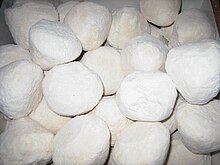Jameed
This article needs additional citations for verification. (October 2007) |
 White Jameed in a shop front | |
| Place of origin | Jordan[citation needed] |
|---|---|
| Main ingredients | laban |
Jameed (Arabic: جميد, literally "hardened") is a Beduin-Jordanian food[citation needed] (mainly the Levant, Iraq, and Arabia) consisting of hard dry laban made from ewe or goat's milk.[1] Milk is kept in a fine woven cheesecloth to make a thick yogurt. Salt is added daily to thicken the yogurt even more and the outside of the yogurt-filled cheesecloth is rinsed with water to allow any remaining whey to seep through. After a few days of salting the yogurt, it becomes very dense and can be removed from the cheesecloth and shaped into round balls. It is then set to dry for a few days. If it is dried in the sun it becomes yellow; if it is dried in the shade it remains white. It is important that the jameed is dry to the core because any dampness can spoil the preservation process. Jameed is the primary ingredient used to make mansaf, the national dish of Jordan.
Origin
Traditionally, Bedouins supplied Jordanian markets with jameed and other sheep and goat dairy products.[1][2] Jameed is used in Jordanian dishes such as fatta, mahashi and mansaf,[1] the latter also being the national dish of Jordan.[2] Karak, Jordan is famous for its high-quality jameed.[2] It is used in other Jordanian dishes such as Kousa Mahshi, Kubbeh blabaniyyeh, Mjalaleh, Rashouf, Madgoga and er-Rgage.[3]
Production
Traditionally, jameed was made in late spring and early summer when sheep's milk is most plentiful. The first step was shaking the yogurt in a leather bag made from sheep or goat leather to separate the butter. The leftover buttermilk was then reduced by boiling until it reached a consistency similar to labaneh (thick yogurt). It could then be salted, shaped into balls, and sun-dried. The dried balls could be preserved for months in sealed boxes without refrigeration as they were very low in moisture. Nowadays, people consume jameed for its flavour rather than lack of refrigeration.[4]
References
- ^ a b c Albala, Ken (2011-05-25). Food Cultures of the World Encyclopedia [4 volumes]: [Four Volumes]. ABC-CLIO. ISBN 9780313376276.
- ^ a b c "Archived copy". Archived from the original on 2011-04-17. Retrieved 2011-03-20.
{{cite web}}: CS1 maint: archived copy as title (link) - ^ "ارتفاع الأسعار يفتح قاموس الأكلات الشعبية في الكرك". وكالة عمون الاخبارية (Ammon News Agency) (in Arabic). Retrieved 2016-03-26.
- ^ A Chemical and Microbial Study of Jameed Cheese Produced in Jordan (1991) Yosef H. Tawalbeh\ University of Jordan Supervisor: Dr. Malik S. Haddadin Page 5, http://www.acnut.com/v/images/stories/pdf/journals/25_english.pdf
See also
External links

